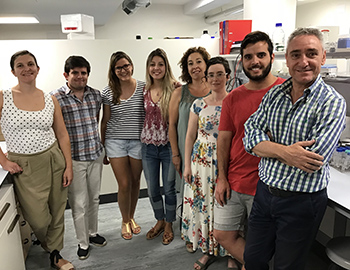RESEARCH GROUP
BIOTECHNOLOGY AREA
MICROBIAL BIOTECHNOLOGY RESEARCH GROUP
STAFF SCIENTISTS:
Olga Zafra PhD
Alba Blesa PhD
Estela Pérez PhD
Raquel Francisco PhD
María Arroyo PhD
GRADUATE STUDENTS:
Daniel García
LINES OF INVESTIGATION
- >Clinical Microbiology.
– Genotypic and phenotypic characterisation of multidrug-resistant enteric bacteria.
– Production of bifunctional antibodies in bacterial systems for therapeutic use.
- >Food microbiology.
– Study of the fermentative and biotechnological potential of non-Saccharomyces wine yeast .
– Evaluation of the polyphenolic content of concentrated grape must for food applications.

SUMMARY
Clinical Microbiology.
- >The increase of antibiotic resistance of pathogenic bacteria has currently become a leading public health problem worldwide. Infections caused by carbapenemase-producing enterobacteriaceae (CPE) have largely increased in the last few years, and in addition, are associated to high mortality rates. The overall objective of this work is to expand our knowledge in the molecular mechanisms that enable the acquisition and dissemination of antibiotic resistance genes in pathogenic bacteria. Moreover, we are interested in determining which other physiological and ecological characteristics are involved in their survival. The aim is to improve diagnosis and treatment, as well as attenuate the processes of resistance dissemination.
- >Monoclonal antibodies are used as drugs for the treatment of different types of cancer. Bifunctional or bispecific antibodies are molecules with two different recognition domains, which allow them to bind two different epitopes. The bispecific LiTe antibody has two different domains: (i) scFv antiCD3 recognising CD3+ T-lymphocytes; and (ii) VHH (Camelid heavy-chain antibody) anti-EGFR that allows binding to tumour cells expressing surface endothelial growth factor receptor (EGFR+) (Molgaard et al., 2018). We are trying to optimise conditions needed to express the LiTe antibody in E. coli and its later purification to be used in anticancer therapy.
Food Microbiology.
- >The aromatic complexity and the quality of wines is highly influenced by the yeast species involved in the fermentation process. The objective of this project is selecting strains from different geographic locations to study their fermentative characteristics and biotechnological potential. To do so, we carry out fermentations with different yeast combinations, study their population dynamics throughout the fermentation process, and analyse quantitative and qualitatively a set of compounds (alcohols, acetates, esters) directly involved in the aromatic complexity of wine. These analyses allow the selection of the best strains to be used as starter cultures to produce wines with the desired quality and organoleptic characteristics.Polyphenols are important antioxidant compounds naturally found in plant foods. Grape polyphenols are well known, but the amount of these compounds in grape must has not been well characterised until now. The concentrated grape must is a product of great demand in the food industry, for infant feeding. Our research is focused to determine if the process of juice concentration affects the polyphenolic content of the final product and to what extent.
PUBLICATIONS:
Baselga, I., Zafra, O., Pérez Lago, E., Francisco-Álvarez, R., Rodríguez-Tarduchy, G., Santos, C. (2017). An AFLP based method for the detection and identification of indigenous yeast in complex must samples without a microbiological culture. Int. J. Food Microbiol. 241: 89-97. http://dx.doi.org/10.1016/j.ijfoodmicro.2016.09.014.
Calzada, J., Baselga, I., García Martínez, D.J., Lago, E.P., Francisco-Álvarez, R., Rodríguez, L., Prieto, A.M., Santos, C. (2015) Selection of indigenous non-Saccharomyces yeast strains through fermentative potential via GC analysis. Oeno 2015. pp. 305-307. Vigne et vin publications internationals.
Calzada, J., Baselga, I., Lago, E. P., Francisco-Álvarez, R., González, A., Rodríguez-Tarduchy, G., Santos, C. (2013). Influence of indigenous non-Saccharomyces yeast on the aromatic profiles of red wines. Proceedings of the 36th World Congress of Vine and Wine.
Baselga, I., Lago, E. P., de Laorden, E. H., Francisco-Álvarez, R., Rodríguez-Tarduchy, G., Iglesias, M., Santos, C. (2012). Molecular characterization of indigenous yeast strains isolated from Ribera de Duero Spanish wineries. Oeno 2011. pp. 529 – 534. Dunod Ed.
PROJECTS:
Production of the bispecific antibody EGFRxCD3 as a LiTe (Light T cell engager), using E. coli as biofactory.
Funding: MERCK-UFV Chair
Study of the prevalence and dissemination of antibiotic resistance factors in pathogenic bacteria isolated from patients with sepsis hospitalised in the Community of Madrid
Funding: Universidad Francisco de Vitoria
Study of the fermentative and biotechnological characteristics of non- Saccharomyces wine yeasts
Funding: Universidad Francisco de Vitoria
Evaluation of concentrated grape must for feeding purpose: identification and quantification of polyphenols.
Funding: Mostos Españoles S.A.
Study of the genetic stability of different varieties of the edible fungi Agaricus bisporus and Pleurotus ostreatus.
Funding: Gurelan S. Coop
PATENTS:
- National Patent 201500058: Method of identification of wine yeast strains from must samples. Grant date: 18-02-2017.
Institute of Life Sciences
9:00 a.m. to 2:00 p.m. Monday to Friday





